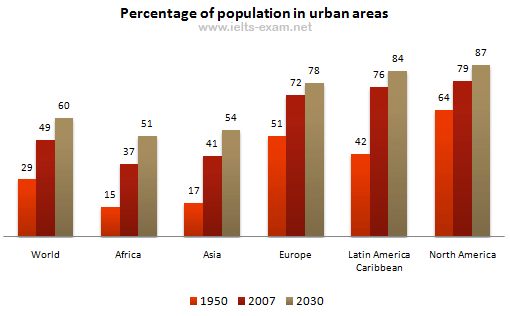IELTS Writing Task 1 #98
Test Tip
Do not copy information from the question paper, use your own words.
Make sure that you describe the most important information and that your
figures are accurate.
When describing trends in the IELTS test it is best to use:
- the
simple past to talk about ‘finished’ time, e.g. in 1950, last year.
- the
present perfect to talk about ‘unfinished’ time, e.g. since 1950, ever,
this year
- a future tense to talk
about future time, e.g. in 2030, next year
We often use the following expression when talking about future or predicted
data, because the simple future is a little too certain:
… are/is (un)likely
… are/is predicted to
… are/is expected to
For example: Between 1950 and 2030, the proportion of the world's population
is expected to double.
OR we use a verb such as predict and a future tense.
For example: It is predicted that the proportion of the world's population
will double by 2030.
You should spend about 20 minutes on this task.
The bar chart below gives information about the percentage of the population living in urban areas in the world and in different continents.
Summarise the information by selecting and reporting the main features, and make comparisons where relevant.
Write at least 150 words.

Source: UN, World Urbanization Prospects: The 2005 Revision (2006) and Carl Haub, 2007 World Population Data Sheet.
Read the following sample answer. Complete the answer by filling the gaps with the words in the box.
The bar chart the urbanization percentage of the world in 1950 and this with the percentage in 2007 and the projected percentage for 2030.
Between 1950 and 2030, the proportion of the world's population residing in cities is expected to , growing from 29% to 60%. However, this rate is less in some continents than others.
For example, 64% of the population of North America was urban in 1950, increasing to 79% by 2007. , just 15% of the African population was urban in 1950, but this rose to 37% by 2007. This represents one of the urbanization rates in the world, even though the percentage of Africans in urban areas is still than the world average.
It is also clear from the graph that, urbanization in Latin America is projected to be higher than Europe in 2030, being lower in 1950.
(151 words)